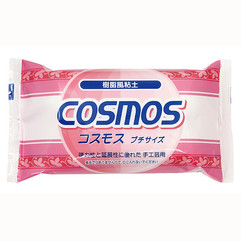Japanese resin air dry clay review (Cosmos, Grace, Modena Color & Hearty)
- Crafta Hub
- Aug 20
- 3 min read
I have been dedicating a significant amount of time to exploring Japanese blogs that showcase artificial clay food, and I am truly amazed by the immense talent of these bloggers! The level of realism in some of their creations is absolutely mind-blowing. This has inspired me to consider trying my hand at creating something similar.
By the way, I thoroughly enjoy working with polymer clay. However, the only drawback is that it requires baking, which limits the ingredients that can be mixed and baked together. That's why I am intrigued to experiment with air-dry clay and see what kind of outcomes I can achieve.
Let’s compare these Japanese resin air-dry clays: Cosmos, Grace, Hearty, and Modena. Japanese resin air dry clay review (Cosmos, Grace, Modena Color & Hearty)
Here’s a breakdown based on available information:
Cosmos Resin Air Dry Clay: is popular among clay and miniature fake food artists across Japan. It’s great for making realistic fake donuts, chocolate, candy, fruit, and cakes, and also ideal for making fake flowers. It captures details well and can be used with molds or sculpted by hand and tools
Packaging: Comes in 250g packs with 2 tubes of white clay. The packaging prevents drying out if you can’t use it all at once.
Texture: Smooth and elastic, slightly sticky when fresh. Softens after kneading.
Coloring: for a bold white color put some white acrylic paint mix in it to have a whiter finish. Mixes well with acrylic or oil paint for pastel tones. Colors become more vibrant when dried.
Use: Pastry items, such as puff, cookies, donuts, cake rolls, macaroons, and candies.
Surface: Dries quickly, so work efficiently for textures.
Shrinkage: About 10-15% as moisture evaporates during drying
Transparency: Slightly translucent finish when it's dried.
Grace Light Weight Clay: is a resin-type clay made from cereal flour. It’s easy to thin out and maintains excellent elasticity even when dried. It’s characterized by its strength against cracking. It’s great for figurines, miniatures, and flower making. It’s also translucent and shines slightly after drying
Similar to Cosmos, from the same company.
Packaging: 200g per pack (2 tubes). Mint green packaging.
Texture: Soft and elastic.
Use: Great for making fruits/ fruit canes.
Transparency: Nice translucent finish when it's dried. More translucent than Cosmos.
Note: Can’t color it with very dark colors due to its white base.
Hearty Clay: is super lightweight, and pliant, doesn’t stick, and is easy to handle. It’s ideal for almost any modeling task but especially suited to lightweight figurines, flowers, miniatures, etc. It’s also great for intricate, detailed, and delicate work; jewelry making, flowers, miniatures, dolls, and embellishments.
Polymer clay is soft and easily kneadable.
Ideal for small items like figurines.
Mixes well with acrylic paint for color changes and intricate details.
It's not as smooth, it has some little fibers in it and feels like a paper texture.
Use: Great for making ice cream, marshmallows and macaroons, cookies, layered cake, or pie, you can cut it into slices after drying.
Transparency: It's not translucent.
It's very flexible and light when dried. It feels like foam.
Modena Air Dry Polymer Clay: is a soft, flexible air dry clay that is also known as cold porcelain. It’s great for intricate, detailed, and delicate work; jewelry making, flowers, miniatures, dolls, and embellishments. It sets quickly and air dries in 24 hours to a flexible yet firm, velvety consistency.
Lightweight, flexible, and 50% lighter than regular Modena clay.
Slightly flexible, durable, and waterproof when dry.
Pure white like ceramic; mix acrylics or oil colors for custom shades.
Transparency: It is described as “translucent,” which suggests some level of transparency.
To store Japanese resin air-dry clay and prevent it from drying out, follow these steps:
Add Moisture: Before wrapping the clay, add a wet paper towel to the jar, it will help to keep the clay moist for a little longer than without it.
Wrap in Cling Film: Wrap the clay in cling film (food wrapping film) to protect it from air exposure.
Jar: Place the cling-wrapped clay into an airtight jar such as a canning jar and seal it tightly.
Avoid Sunlight and Heat: Store the jar in a cool, dry place away from direct sunlight or hot areas.
Remember, the best clay for you depends on the specific requirements of your project. It’s always a good idea to experiment with different clays to find the one that suits your needs the best. Happy crafting!








Comments